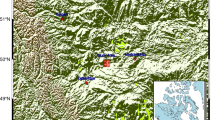Abstract
The first generation coherence algorithm (namely C1 algorithm) is based on the statistical cross-correlation theory, which calculates the coherency of seismic data along both in-line and cross-line. The work, based on texture technique, makes full use of seismic information in different directions and the difference of multi-traces, and proposes a novel methodology named the texture coherence algorithm for seismic reservoir characterization, for short TEC algorithm. Besides, in-line and cross-line directions, it also calculates seismic coherency in 45° and 135° directions deviating from in-line. First, we clearly propose an optimization method and a criterion which structure graylevel co-occurrence matrix parameters in TEC algorithm. Furthermore, the matrix to measure the difference between multi-traces is constructed by texture technique, resulting in horizontal constraints of texture coherence attribute. Compared with the C1 algorithm, the TEC algorithm based on graylevel matrix is of the feature that is multi-direction information fusion and keeps the simplicity and high speed, even it is of multi-trace horizontal constraint, leading to significantly improved resolution. The practical application of the TEC algorithm shows that the TEC attribute is superior to both the C1 attribute and amplitude attribute in identifying faults and channels, and it is as successful as the third generation coherence.
Similar content being viewed by others
References
CHOPRA S, MARFURT K J. Seismic attributes—A historical perspective [J]. Geophysics, 2005, 70(5): 3SO–28SO.
GRANA D, MUKERJI T, DVORKIN J, MAVKO G. Stochastic inversion of facies from seismic data based on sequential simulations and probability perturbation method [J]. Geophysics, 2012, 77(4): M53–M72.
WANG Shang-xu, LI Xiang-yang, DI Bang-rang, BOOTH D. Reservoir fluid substitution effects on seismic profile interpretation: A physical modeling experiment [J]. Geophysical Research Letters, 2010, 37(10): L10306.
YUAN San-yi, WANG Shang-xu. Spectral sparse Bayesian learning reflectivity inversion [J]. Geophysical Prospecting, 2013, 61(4): 735–746.
WANG Yang-hua. Reservoir characterization based on seismic spectral variations [J]. Geophysics, 2012, 77(6): M89–M97.
SARASWAT P, SEN M K. Artificial immune-based self-organizing maps for seismic-facies analysis [J]. Geophysics, 2012, 77(4): O45–O53.
BAHORICH S M, FARMER L S. 3-D seismic discontinuity for faults and stratigraphic features: The coherence cube [J]. The Leading Edge, 1995, 14(1): 1053–1058.
MARFURT K J, KIRLIN R L, FARMER S L, BAHORICH S M. 3-D seismic attributes using a semblance-based coherency algorithm [J]. Geophysics, 1998, 63(4): 1150–1165.
MARFURT K J, SUDHAKER V, GERSZTENKORN A, CRAWFORD K D, NISSEN S N. Coherency calculations in the presence of structural dip [J]. Geophysics, 1999, 64(1): 104–111.
HARALICK R M, SHANMUGAM K, DINSTEIN I. Textural features fro image classification [J]. IEEE Transaction on Systems, Man and Cybernetics, 1973, SMC-3(6): 610–621.
LIU Lang, CHEN Jian-hong, WANG Ge-ming, LAO De-zheng. Multi-attributed decision making for mining methods based on grey system and interval numbers [J]. Journal of Central South University, 2013, 20(4): 1029–1033.
WEST, B P, MAY S R, EASTWOOD J E, ROSSEN C. Interactive seismic facies classification using textural attributes and neural networks [J]. The Leading Edge, 2002, 21(10): 1042–1049.
GAO Deng-liang. 3D seismic volume visualization and interpretation: An integrated workflow with case studies [J]. Geophysics, 2009, 74(1): W1–W12.
YENUGU M, MARFURT K J, MATSON S. Seismic texture analysis for reservoir prediction and characterization [J]. The Leading Edge, 2010, 29(9): 1116–1121.
MATOS M C, YENUGU M, ANGELO S M, MARFURT K J. Integrated seismic texture segmentation and cluster analysis applied to channel delineation and chert reservoir characterization [J] Geophysics, 2011, 76(5): 11–21.
YUAN San-yi, WANG Shang-xu. Edge-preserving noise reduction based on Bayesian inversion with directional difference constraints [J]. Journal of Geophysics and Engineering, 2013, 10(2), 25001–25010.
Author information
Authors and Affiliations
Corresponding author
Additional information
Foundation item: Project(2013CB228600) supported by the National Basic Research Program of China; Project(2011A-3606) supported by the CNPC “12.5” Program of China
Rights and permissions
About this article
Cite this article
Chuai, Xy., Wang, Sx., Shi, Pd. et al. Applications of texture attribute analysis to seismic interpretation. J. Cent. South Univ. 21, 3617–3626 (2014). https://doi.org/10.1007/s11771-014-2344-2
Received:
Accepted:
Published:
Issue Date:
DOI: https://doi.org/10.1007/s11771-014-2344-2




